#Fileserver
Explore tagged Tumblr posts
Text
Προστασία Εταιρικών Δεδομένων με AVG File Server Business Edition
Ασφαλίστε τους File Servers σας με την Επαγγελματική Προστασία του AVG
Στην εποχή της ψηφιακής πληροφορίας, η ασφάλεια των εταιρικών δεδομένων αποτελεί πρωταρχική ανάγκη για κάθε επιχείρηση. Ειδικά όταν πρόκειται για την προστασία των file servers, όπου αποθηκεύονται κρίσιμες πληροφορίες, η επιλογή της κατάλληλης λύσης ασφάλειας είναι ζωτικής σημασίας. Εδώ είναι που το AVG File Server Business Edition έρχεται στο προσκήνιο, προσφέροντας κορυφαία προστασία για τις εταιρικές σας υποδομές.
Οι file servers αποτελούν τον πυρήνα των επιχειρησιακών δραστηριοτήτων, καθώς φιλοξενούν σημαντικά έγγραφα και πληροφορίες. Ένα κενό στην ασφάλεια μπορεί να οδηγήσει σε παραβιάσεις δεδομένων, απώλεια σημαντικών πληροφοριών και, κατ' επέκταση, σε οικονομικές ζημίες και πλήγμα στην φήμη της επιχείρησης. Για να αποφύγετε τέτοιου είδους περιστατικά, η επιλογή ενός αξιόπιστου λογισμικού όπως το AVG File Server Business Edition είναι απαραίτητη.
Το AVG File Server Business Edition προσφέρει προηγμένες δυνατότητες προστασίας, που περιλαμβάνουν ανίχνευση κακόβουλου λογισμικού σε πραγματικό χρόνο, προστασία από ransomware, και αποτροπή μη εξουσιοδοτημένων προσβάσεων. Με την ενσωμάτωση τεχνολογιών τεχνητής νοημοσύνης, το λογισμικό είναι σε θέση να ανιχνεύει και ��α αποκλείει ακόμη και τις πιο εξελιγμένες απειλές, προτού αυτές προλάβουν να επηρεάσουν τα δεδομένα σας.
Μια από τις σημαντικότερες δυνατότητες του AVG File Server Business Edition είναι η ευκολία διαχείρισης. Μέσω ενός κεντρικού πίνακα ελέγχου, οι διαχειριστές IT μπορούν να παρακολουθούν και να διαχειρίζονται την ασφάλεια όλων των servers από μία ενιαία πλατφόρμα. Αυτό εξασφαλίζει όχι μόνο την άμεση απόκριση σε οποιαδήποτε απειλή, αλλά και την οικονομία χρόνου και πόρων για την επιχείρηση.
Επιπλέον, το AVG παρέχει συνεχή υποστήριξη και ενημερώσεις ασφαλείας, διασφαλίζοντας ότι οι file servers σας είναι πάντοτε προστατευμένοι από τις τελευταίες απειλές. Η συνεχής ενημέρωση του λογισμικού είναι καθοριστική για την αντιμετώπιση των νέων προκλήσεων στον τομέα της κυβερνοασφάλειας.
Καθώς εξετάζετε τις επιλογές σας για προστασία των file servers, αξίζει να λάβετε υπόψη το κόστος και την αποτελεσματικότητα. Μπορείτε να μάθετε περισσότερα για την avg file server business edition τιμή και τις δυνατότητες που προσφέρει, ώστε να εξασφαλίσετε ότι η επένδυσή σας θα αποδώσει τα μέγιστα.
Συνοψίζοντας, η ασφάλεια των file servers δεν πρέπει να θεωρείται δευτερεύουσα προτεραιότητα. Με το AVG File Server Business Edition, μπορείτε να είστε βέβαιοι ότι οι εταιρικές σας πληροφορίες είναι ασφαλείς και προστατευμένες. Εξασφαλίστε την επιχειρηματική σας συνέχεια και την ακεραιότητα των δεδομένων σας με μια λύση που συνδυάζει αξιοπιστία, ευκολία στη χρήση και προηγμένη τεχνολογία.
0 notes
Text
Server Products Types: Understanding Size, Share, and Growth Trajectories
The global server market size is estimated to reach USD 175.29 billion by 2030, exhibiting a CAGR of 9.8% from 2024 to 2030, according to the recent reports of Grand View Research, Inc. Continued advances in emerging technologies, such as AI, IoT, big data, cloud computing, and 5G, and the growing adoption of innovative solutions based on these technologies across various industries and industry verticals are driving the demand for edge data centers in emerging economies.
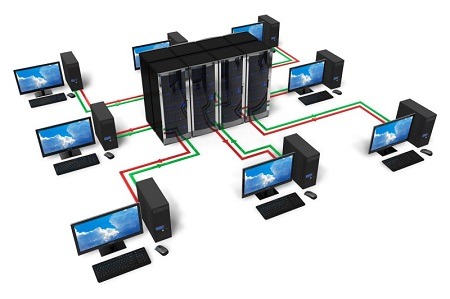
Server Market Report Highlights
The rack segment is expected to register a CAGR of 11.3% from 2024 to 2030 in the server market. The segment growth can be attributed to the growing need for scalable data centers, high-density computing, and advancements in emerging technologies, such as IoT, cloud computing, and edge computing, creating vast growth opportunities for market players.
The large enterprise segment is expected to register a CAGR of 10.4% from 2024 to 2030 in the server market. Large enterprises are shifting their focus toward hosted application servers because they can handle workloads from multiple sites, typically from the same database.
The direct segment is expected to register a CAGR of 11.0% from 2024 to 2030 in the server market. Direct distribution can shorten lead times by sending goods directly to customers when they are ready for deployment. These benefits are expected to further supplement the growth of the direct channel during the forecast period.
The IT & telecom segment expected to register a significant CAGR from 2024 to 2030 in the server market. The IT industry has seen a growing implementation of cloud-based services over on-premises ones. Subscribers now get most services through a single service provider. Furthermore, mobile phones' constantly evolving multimedia capabilities are giving rise to new issues related to after-sales service delivery and execution.
Asia Pacific is anticipated to emerge as the fastest-growing region over the forecast period at a CAGR of 10.7% in the server market. The growth of the Asia Pacific market can be attributed to significant players in the region, including Baidu, Huawei Technologies Co., Ltd., Tencent Cloud, and Alibaba.com. Moreover, the region has been witnessing high growth in digitalization, especially in countries such as India.
For More Details or Sample Copy please visit link @: Server Market Report
As businesses move to private and public clouds, edge cloud, co-location facilities, and data centers have started utilizing software-defined networks (SDNs) and virtualization to facilitate the implementation of new data analytics models. However, having realized that the incumbent servers cannot handle the complex workloads, market players in the region are introducing new server designs with higher computational power.
The cloud computing sector attracts small enterprises by offering scalable infrastructure and services. Cloud computing also offers benefits such as on-demand self-service, broad network access, resource pooling, flexibility in terms of cost and time, transparency in the form of usage reports and timely updates regarding consumption rates, and cost updates to customers. It not only helps deploy business quickly but also considerably reduces operational costs. Since data security and recovery are critical concerns for small organizations, they prefer to deploy data on private clouds.
Furthermore, companies are utilizing big data analytics to provide the best services to their customers. Cloud services assist in optimizing business processes for small enterprises. These factors would further supplement the demand for servers in small enterprises during the forecast period.
Server platforms have evolved to incorporate features and capabilities once considered add-ons and were integrated only for advanced deployments. The architecture, product capability, and management and development tools account for a substantial share of the total ownership costs of owning the servers. The total ownership costs include the initial design, deployment, and recurring costs. The initial design and deployment costs cover the costs incurred on hardware, software, installation & setup, integration & testing, and initial deployment. On the other hand, the recurring costs include the costs incurred for technical support & consultancy, implementation, management & administration, monitoring & diagnostics, server downtime, and upgrades.
Additionally, the rise of advanced applications requiring particular settings and substantial computational power from users and providers is fueling the shift toward cloud servers for optimized performance. Businesses increasingly turn to virtual or cloud servers to improve their worldwide networking potential and reduce the expenses associated with operating and maintaining their IT systems. Furthermore, cloud service providers must allocate considerable resources to maintain cooling systems due to physical servers' higher heat output. Consequently, strategies like server leasing and virtualization have become more popular lately.
List of Major Companies in the Server Market
ASUSTeK Computer Inc.
Cisco Systems, Inc.
Dell Inc.
FUJITSU
Hewlett Packard Enterprise Development LP
Huawei Technologies Co., Ltd.
Inspur
Intel Corporation
International Business Machines Corporation
Lenovo
#ServerMarket#DatabaseServers#FileServers#PrintServers#ProxyServers#EdgeServers#ServerNetwork#ServerComputer#ComputerNetworks#ServerTechnology#CloudServer#ServerHardware
0 notes
Text
Another Method of Wirelessly Transferring Epubs to Kobo (full guide on dreamwidth)
After seeing this video of KoboFileServer working, I really wanted to get it to work on my Kobo Libra Colour! I finally got it to work, and it's a great alternative to send.djazz.se
KoboFileServer is able to convert to kepub locally on the kobo, which I think is the greatest benefit of this method over Send Djazz. I also like the fact that this isn't reliant on uploading the file to a 3rd party server.
I wrote up an in depth guide on my blog, but the basic steps to get it working are:
Have NickelMenu Installed
Install FBInk (an updated version with the correct binaries for newer Kobo devices, I had to make my own version for this: FBInk for KLC/Clara BW/Tolino etc. (download this, rename to KoboRoot.tgz, and then install)
Install KoboFileSever
Configure Nickelmenu with the correct commands (check the KoboFileServer link)
Success! Use the nickelmenu commands to toggle the wifi and fileserver as needed. You can use the Import Books command to find the book after it's been transferred over.
Dreamwidth guide
15 notes
·
View notes
Note
Hello!
Checking out your blog, I noticed that you use C++ and seem quite knowledgeable on it, so I wanted to ask for your help (if it doesn't bother you!).
I've completed the two C++ courses in SoloLearn (which are quite superficial, but serve as good introductions, I believe), and I'm currently reading "The C++ Programming Language", by Bjarne Stroustrup. My issue is that I'm a bit afraid of not really understanding anything and/or being unable to write any functional code by myself. Therefore, I wanted to ask if you had any resources and/or tips that could be helpful for a beginner like me (the only language I've ever used before is HTML, and so I thought it was a good idea to go straight to C++ for the challenge of it xd).
It NEVER bothers me to blabber about code! :D
I LOVE C++
So first a long rant, and then my answer :3
C++ will probably forever be my favorite langauge.
But many do not like it, and it is actually somewhat rare to see as a language a professional uses.
Why? Because one should use a language for what it is good at.
And what is C++ good at?
Well, one of its neatest features is that it is a object oriented language.
It is also a language where you can create objects, but the language ITSELF is object oriented.
C++ is a derived class of the baseclass C
And it have the same philosophy as C
You can do ANYTHING!
You can EASILY write garanteed memory safe code in C++
You can write psydocode that have the same safety garantees as Rust.
Or you can go for 100% performsnce, dancing with void pointers and GOTOs!
Craft a class so it gets build, moved, removed used and works EXACTLY how you want it to! Down to the smallest details!
Write halfway object oriented and half functional!
If it can be done on a computer, it can be done in C++!
It may not be the language most often used. Often there are better languages for creating things
But knowing C++ means that you never again have to fully learn another language.
A C++ programmer KNOWS what a computer can do, so it is just a question of googeling the syntax for whatever language we are writing it in that day :D
Rant over. Answer time! :D
When I have to get a bit familiar with a new language I usually build a HTTP server :3
It is easy enough to look up for help, it means you work with everything you know
Slap it on a raspberry pie 0 or 3 depending on your wallet and bam! You have your own fileserver! :D
Connect a SSD into the raspberry pie 3 and bam, you now have your own cloud storage! :D
That is ALWAYS a useful thing :3
Keep it on your own network with a passwork and use MDNS to use it and it is 100% safe.
Because you piggybag on all the security wirless networks come with these days :3
8 notes
·
View notes
Text
Like 90% of the office fileserver is taken up by a very small number of ridiculously-large media files + Cellebrite device exports. Most of it is from closed cases and will never be looked at again, if it ever was before. The nature of the digital court record is that a lot of what ends up in there is unrelated to the case. A week of uncompressed security camera footage because the building managment at the scene of the crime didn't configure their cameras right and prosecution said "we'll sift through it later for the relevant bits, for now let's just get it in the record"; 90 hours are blank because some leaves got stuck to the camera lens on Tuesday morning; 8 months in someone figures out it also wasn't even the right week. "Am I allowed to delete this" we don't know. We don't know anything.
5 notes
·
View notes
Text
great googly moogly, I've solved the Kodi Conundrum
Issue: Kodi has Very Specific Naming Conventions. So do I . We do not share these conventions. I refuse to bow to the machine. Solution: Symlinks
Issue: I have a remote fileserver, you cannot UNC hard symlinks Solution:Kodi does fine with soft symlinks
Issue: Symlinks in windows are very different to linux, where they’re more like shortcuts as windows has them hard coded to the kernel. Every single machine running kodi - currently two, lounge and bedroom, possibly a third with the brewery - will need its own symbolic link of every. single. file. on my file server named correct in order to scrape them and show them. My fileserver has 12tb on it. Solution: Script written that will ask for a share name in UNC, then drill down every subdirectory and replicate the whole tree symlink form on local machine in directory of choice.
Issue: Still not in kodi naming convention Solution: filebot portable, which is free. Rename symlinks to match TVDB. Original files untouched.
Issue: faults will occur if source files are moved or renamed Solution: I just wrote another friggin’ script that will go through every single symlink and subdirectory and list all that do not resolve in a txt file called broken_links.txt. Run that once a month or so and update as required and I’m dancing.
Then it’s just upkeep with new symlinks as files/folders added and double checking it scrapes ok.
0 notes
Text
Was ist ein Server – und warum du längst mit einem arbeitest, ohne es zu merken

Server. Dieses Wort schwirrt überall herum – in Büros, in Rechenzentren, in Gesprächen über Cloud, Hosting oder IT-Infrastruktur. Und vielleicht denkst du dir: „Klar, das ist doch so ein großer Kasten, der irgendwo im Keller steht und irgendwelche Daten speichert.“ Nicht ganz falsch – aber auch nur ein winziger Ausschnitt eines sehr viel größeren Bildes. https://youtu.be/TJd1KrHtfzo
Was genau ist ein Server?
Ein Server ist im Grunde nichts anderes als ein Computer, der darauf ausgelegt ist, anderen Geräten – den sogenannten Clients – Dienste bereitzustellen. Das kann ziemlich vieles sein: eine Website ausliefern, E-Mails verwalten, Dateien speichern oder Datenbanken bereithalten. Stell dir einen Server wie einen fleißigen Kellner vor, der in einem gut besuchten Restaurant Bestellungen entgegennimmt, Speisen aus der Küche holt und sie an den richtigen Tisch bringt. Nur dass in diesem Fall die Gäste Computer oder Smartphones sind – und die Speisen eben Daten.
Die verschiedenen Arten von Servern
Nicht jeder Server ist gleich. Es gibt verschiedene Typen, je nachdem, welchen Dienst sie bereitstellen: Webserver Sie liefern Websites aus – also HTML, CSS, Bilder, alles, was du beim Surfen siehst. Ohne Webserver würdest du beim Aufruf einer Website einfach... nichts sehen. Mailserver Hier laufen E-Mails zusammen, werden verteilt, empfangen, weitergeleitet. Sie sind die unsichtbaren Postämter des Internets. Datenbankserver Sie verwalten riesige Mengen an Daten, speichern, sortieren und stellen sie bereit. Wenn du etwa in einer App auf „Alle Bestellungen anzeigen“ klickst, fragt die App beim Datenbankserver nach. Fileserver Der klassische Speicherort für Dokumente, Bilder, Videos oder was du sonst noch ablegen willst. Vor allem in Unternehmen häufig im Einsatz. Virtuelle Server Hier geht’s weniger um Hardware, sondern um Software. Ein physischer Server wird dabei in mehrere virtuelle Server aufgeteilt – praktisch, effizient und flexibel.
Hardware: Was steckt in einem Server?
Auch wenn viele Server in riesigen Rechenzentren stehen, ähnelt ihre Technik im Inneren stark einem normalen PC – nur leistungsstärker, robuster und für den Dauerbetrieb ausgelegt. Die wichtigsten Komponenten: - Prozessor (CPU): Oft mehrere Kerne, hohe Taktraten, für paralleles Arbeiten gemacht - Arbeitsspeicher (RAM): Je mehr, desto besser – viele Server laufen mit 128 GB RAM oder mehr - Festplatten (HDD/SSD): Für schnelle Datenverarbeitung meist in RAID-Systemen verbaut - Netzwerkkarte: Damit der Server mit dem Netzwerk kommunizieren kann – und das möglichst schnell - Netzteil(e): Oft redundant, damit der Server auch bei einem Defekt weiterläuft
Server im Alltag – du nutzt sie ständig
Du musst keinen eigenen Server im Keller haben, um mit Servern zu arbeiten. Tatsächlich nutzt du sie täglich, oft ohne es zu merken. Wenn du: - eine Website besuchst, - eine Serie auf Netflix schaust, - ein Dokument in der Cloud speicherst, - mit deinem Team in Microsoft Teams schreibst, - oder einfach nur dein Smartphone benutzt – … dann kommunizierst du mit zig verschiedenen Servern. Einige davon stehen vielleicht in Irland, andere in Frankfurt, wieder andere in einem Rechenzentrum irgendwo in den USA.

Photo By Unsplash
Server kaufen, mieten oder lieber gleich in die Cloud?
Wenn du ein Unternehmen leitest oder IT-affin bist, stellst du dir irgendwann die Frage: Brauche ich eigene Server? Und wenn ja, kaufe ich einen, miete ich oder setze ich gleich auf die Cloud? Beim Kauf eines Servers hast du eine einmalige Investition, aber dafür die volle Kontrolle über die Hardware. Du kannst alles selbst bestimmen – von der Konfiguration bis zur Wartung. Der Nachteil: Die Anschaffung ist teuer, Wartung und Stromkosten musst du selbst stemmen, und du brauchst Fachwissen oder IT-Personal. Gemietete Server – sogenannte Dedicated Server – bieten dir planbare Kosten und entlasten dich von der Hardware-Wartung. Du nutzt die Leistung, ohne dich um Reparaturen oder Ersatzteile kümmern zu müssen. Allerdings hast du etwas weniger Kontrolle, und du zahlst dauerhaft monatliche Gebühren. Die Cloud-Variante – also virtuelle Server bei Anbietern wie AWS, Azure oder Google Cloud – punktet mit Flexibilität und Skalierbarkeit. Du kannst Ressourcen schnell hoch- oder runterfahren, zahlst nur, was du brauchst, und bist sofort startklar. Aber: Du bist stark vom Anbieter abhängig, und Datenschutzfragen können komplex sein – besonders in Europa. Ein Blick auf Anbieter lohnt sich – etwa auf Happyware.com, wo du Serverlösungen findest, die auf deine Anforderungen zugeschnitten sind. Von klassischen Tower-Servern bis zu High-Density-Lösungen im Rack-Format ist dort einiges dabei.
Sicherheit und Verfügbarkeit – zwei große Themen
Server müssen zuverlässig laufen. Deshalb ist Redundanz das Zauberwort: doppelte Netzteile, mehrfach abgesicherte Datenleitungen, gespiegelte Festplatten. Und selbst dann ist ein Notfallplan Pflicht: Backups, Recovery-Prozesse, Monitoring – all das gehört zur Serverpflege dazu. Gleichzeitig ist Sicherheit ein Riesenthema. Ein Server, der nicht richtig abgesichert ist, ist ein offenes Scheunentor für Hacker. Firewalls, regelmäßige Updates, starke Passwörter und Zugriffsbeschränkungen sind Basics – und längst nicht alles.
Fazit: Server sind die stillen Arbeitstiere unserer digitalen Welt
Server sind unsichtbar und unverzichtbar zugleich. Sie machen die digitale Welt überhaupt erst möglich – von kleinen Websites bis zu globalen Plattformen. Und auch wenn du keinen eigenen Server betreibst: Du bist mittendrin. Jeden Tag. Ob du selbst einen brauchst, hängt ganz von deinen Anforderungen ab. Wichtig ist: Verstehe, was ein Server kann – und was du damit erreichen willst. Denn nur dann holst du das Beste aus dieser Technologie heraus. Read the full article
0 notes
Text
Cladograms, the ~120 years journey from accounting tabulators to benevolent Artificial Super Intelligence (16^12 thread - 0x23/?)

On the planet of Angora, fourty-eight Civs compete within the world congress, among these are twelve majors which constitute the biggest blocks in such a worldly communal assembly...
Nisian Conglomerate (Assyria + Morocco)
Polish Czardom
Shoshone Union (Paiute, Colorado, Utchewn, Nahuatl...)
Mayan Theocracy
Incan Empire
Carthaginian Republic
Vietnamese Dominion
Samoan Shogunate
Inuit Assembly
Aremorici Federation
Angolan Commonwealth
Georgian Syndicate

Research study for 16^12 technologies?
Perseus: Cladograms FileSystem + FileServers, Nucleus MicroKernel, KVM/Nix/Dis? Hypervisor,
Steel Bank Common Lisp, RISC-V Assembly, OpenDylan, Smalltalk, A2 Bluebottle Oberron-2?, Tcsh-flavored? Rc -> Fish-flavored Es, HolyC -> ZealC + DolDoc as documentation system, SimH PDP8 emulator, AGPL (strong copyleft) license software, MUSL C library, GNU Emacs, FreeBASIC ecosystem, OGG container format, KDE Liquid/Plasma, QOI, JPEG XL, TIFF, Opus, Theora, Matroska, OpenEXR, UTV, USD, Daala, Dirac;
Grafx2, OurPaint, Krita, Kate, KDevelop, K2B, Timeshift, ImageMagick, G'MIC, some SoundTracker program?, OpenSimulator, QOwnNotes, Vim, TiddlyWiki, Argdown+Markdown, TreeSheets, Red Eclipse on Tesseract Engine, Blender, (with Func_Godot addon) Godot, Ironwail (Quake engine port), Pixelorama, LibreSprite, MEML, Common Lisp Object System + Expert Systems, Computer Algebra System, R Markdown, LibreWolf, Firefox, Lynx, Itch, Gog Galaxy, Steam, Elisa, LabPlot, Kig, Step, Thunderbird, Okteta, WozMon...
When we think of a legendary duo, Kate & Ava comes ahead firsthand.
BookNookRook / VerbSubjectLambda (Kate) & GeoSyndieServitor / CaretakerSwiftVanguard (Ava);
Intrigues as collections of storylets organized in various threads, operating on loop-y branches (spoke&hub storyworld structure) & statistical decisions with world-state tracking;
0 notes
Text
Beautiful.
Love fileserver hosting jank so much
http://ubuntu.ubuntu.ubuntu.ubuntu.ubuntu.ubuntu.ubuntu.ubuntu.ubuntu.ubuntu.ubuntu.ubuntu.ubuntu.ubuntu.ubuntu.ubuntu.ubuntu.ubuntu.ubuntu.ubuntu.ubuntu.ubuntu.ubuntu.ubuntu.ubuntu.ubuntu.ubuntu.ubuntu.ubuntu.ubuntu.ubuntu.archive.ubuntu.com/ubuntu/ubuntu/ubuntu/ubuntu/ubuntu/ubuntu/ubuntu/ubuntu/ubuntu/ubuntu/ubuntu/ubuntu/ubuntu/ubuntu/ubuntu/ubuntu/ubuntu/ubuntu/ubuntu/ubuntu/ubuntu/ubuntu/ubuntu/ubuntu/ubuntu/ubuntu/ubuntu/ubuntu/ubuntu/ubuntu/ubuntu/ubuntu/ubuntu/ubuntu/ubuntu/ubuntu/ubuntu/ubuntu/ubuntu/ubuntu/
468 notes
·
View notes
Text
what is a connection name for vpn
🔒🌍✨ Get 3 Months FREE VPN - Secure & Private Internet Access Worldwide! Click Here ✨🌍🔒
what is a connection name for vpn
VPN connection identification
In the realm of online security and privacy, having a VPN (Virtual Private Network) connection is becoming increasingly essential. VPNs allow users to establish a secure and encrypted connection to another network over the internet, protecting their online activities from prying eyes and potential cyber threats.
One crucial aspect of using a VPN is the ability to identify and verify the connection for security purposes. VPN connection identification involves confirming the authenticity of the VPN server and ensuring that the data transmitted through the VPN is encrypted and secure.
One way to identify a VPN connection is through the use of protocols such as OpenVPN, IPSec, or SSL/TLS, which provide a secure tunnel for data to pass through. These protocols not only encrypt the data but also authenticate the VPN server, preventing man-in-the-middle attacks and unauthorized access.
Additionally, users can verify their VPN connection by checking for DNS and IP leaks. DNS leaks occur when the user's DNS requests are exposed outside the VPN tunnel, potentially revealing their browsing activities. IP leaks, on the other hand, happen when the user's real IP address is exposed despite being connected to a VPN.
To enhance VPN connection identification, users can also utilize features like kill switches and multihop (or double VPN) capabilities. A kill switch automatically disconnects the internet if the VPN connection drops, preventing any data from being transmitted outside the secure tunnel. Multihop VPNs route data through multiple servers, adding an extra layer of security and anonymity.
Overall, VPN connection identification is crucial for ensuring a safe and private online experience. By understanding how to verify and authenticate VPN connections, users can better protect their data and privacy in an increasingly digital world.
Naming conventions for VPN connections
When setting up a Virtual Private Network (VPN), choosing the right naming conventions for your connections is important to ensure organization and clarity. VPN connections are used to establish secure communication channels over the internet, allowing users to access private networks remotely. Here are some naming conventions to consider when setting up VPN connections:
Location-Based Names: If your VPN connections are based in different physical locations, consider naming them after the city or region where the network is located. For example, you could use names like "NYC-VPN" or "Tokyo-VPN" to easily identify the connection.
Purpose-Based Names: Assign names to VPN connections based on their intended purpose or function. For instance, if a VPN connection is specifically for accessing confidential files, you could name it "SecureAccess-VPN" or "FileServer-VPN".
Protocol-Based Names: Different VPN protocols may be used for various connections, such as OpenVPN or L2TP/IPsec. Naming your connections based on the protocol being used can help differentiate between them, such as "OpenVPN-Connection" or "L2TP-Connection".
User-Based Names: If VPN connections are assigned to specific users or departments, consider naming them after the individual or team using the connection. This can help in tracking usage and assigning permissions accordingly.
Numeric or Alphanumeric Codes: Using numerical codes or a combination of letters and numbers can also be a simple yet effective way to name VPN connections. This method allows for easy sorting and identification, especially when dealing with a large number of connections.
By following these naming conventions for VPN connections, you can streamline management, organization, and troubleshooting processes within your network infrastructure. Consistency in naming will make it easier for administrators and users to locate, connect to, and maintain VPN connections effectively.
Custom VPN connection names
Custom VPN connection names offer users the ability to personalize their virtual private network (VPN) connections according to their preferences or needs. This feature allows individuals or organizations to easily identify and differentiate between multiple VPN connections, enhancing user experience and organizational efficiency.
One of the primary benefits of custom VPN connection names is clarity. Instead of relying on generic or default names assigned by the VPN provider, users can assign names that are meaningful and recognizable to them. For example, users may choose names based on the purpose of the connection, such as "Work VPN," "Personal VPN," or "Travel VPN." This simplifies the process of selecting the appropriate connection, especially when managing multiple connections across different devices or locations.
Moreover, custom connection names can contribute to security and privacy. By using descriptive names that do not reveal sensitive information, users can mitigate the risk of inadvertent exposure of their VPN usage. For instance, rather than using names that disclose specific locations or networks, users can opt for more generic identifiers.
Custom VPN connection names also facilitate organization and management. In corporate settings, IT administrators can assign standardized naming conventions to VPN connections, making it easier to monitor and troubleshoot network activity. This streamlines administrative tasks and promotes consistency across the organization's network infrastructure.
Furthermore, the ability to customize connection names can cater to individual preferences and workflows. Whether users prioritize convenience, security, or organization, custom names empower them to tailor their VPN experience accordingly.
In conclusion, custom VPN connection names offer a range of benefits, including improved clarity, enhanced security, streamlined management, and personalized user experience. By allowing users to assign descriptive and meaningful names to their VPN connections, this feature contributes to a more efficient and user-friendly VPN experience.
Importance of assigning VPN connection names
Assigning names to VPN connections is a crucial step in managing and organizing your network infrastructure effectively. VPN connection names not only help in identifying different connections easily but also play a significant role in enhancing security and streamlining network operations.
One of the key benefits of assigning VPN connection names is the ability to distinguish between various connections within a network. By giving each connection a unique and descriptive name, network administrators can quickly identify the purpose or location of each connection, making it easier to troubleshoot issues and perform maintenance tasks efficiently.
Moreover, assigning distinct names to VPN connections can contribute to improving security measures within the network. By using names that are meaningful and relevant to each connection, administrators can prevent unauthorized access or confusion among users, enhancing overall network security.
Additionally, having well-defined VPN connection names can help in streamlining network operations and ensuring seamless communication within the system. Clear and informative names can assist users in selecting the appropriate connection for their specific needs, reducing errors and minimizing downtime.
In conclusion, assigning VPN connection names is an essential practice for any organization looking to maintain a secure and efficient network environment. By taking the time to name connections appropriately, businesses can enhance network visibility, security, and overall performance, leading to a more productive and reliable network infrastructure.
How to name VPN connections
Naming your VPN connections is an essential step in organizing and managing your network effectively. A well-thought-out naming convention can make it easier to identify and differentiate between various connections, especially when dealing with multiple devices or networks. Here are some tips on how to name your VPN connections effectively:
Be Descriptive: Choose names that accurately describe the purpose or location of the VPN connection. For example, you could use names like "Work VPN," "Home VPN," or "VPN - Office Network" to distinguish between connections for different environments.
Use Consistent Formatting: Establish a consistent format for naming your VPN connections to maintain clarity and uniformity. You might decide to include specific elements such as the type of connection, location, or purpose at the beginning of each name followed by a hyphen or underscore for separation.
Include Relevant Information: Incorporate relevant details into the names of your VPN connections to provide additional context. This could include information such as the geographical location, department, or specific server being accessed.
Avoid Ambiguity: Steer clear of generic or ambiguous names that could lead to confusion. Instead, opt for names that are clear, concise, and easily understandable to anyone managing the network.
Plan for Scalability: Consider future growth and scalability when naming your VPN connections. Choose a naming convention that can accommodate additional connections or changes to your network infrastructure without becoming overly complex or unwieldy.
Document the Convention: Document your naming convention and make it accessible to anyone who may need to configure or troubleshoot VPN connections. This ensures consistency and facilitates efficient management of the network.
By following these guidelines and implementing a systematic approach to naming your VPN connections, you can streamline network administration and enhance overall efficiency and organization.
0 notes
Text
Best Server OS in 2024 in Five Categories
Best Server OS in 2024 in Five Categories @vexpert #vmwarecommunities #serveros #serveroperatingsystems #bestserveros #virtualization #kubernetes #security #nasos #fileserver #containers #docker #hypervisors #virtualizationhowto #vhtforums
When thinking about the best server operating system in 2024, there are a wide range of use cases that servers are used for. Given the wide variety of those use cases, it would make sense to list the best server OS in each category. From virtualization and containers to file sharing and security, this guide explores the best server OS in 2024 across five key categories. We will attempt to provide…

View On WordPress
0 notes
Text

【残り3枠!|本日開催!】 本日14時から開催の「Shadow Desktop ファイルサーバーオプション」セミナーをご紹介します! 【Shadow Desktop File Server Optionオンラインセミナー】 日時:2023年8月22日(火) 14:00~14:45 場所:Zoom(お申込みいただいた方へミーティングURLをご案内いたします) 費用:無料 お申込みURL:https://us02web.zoom.us/webinar/register/3016915573322/WN_IMDGjFngSC-m1eErJgZmqA
☆Shadow Desktop File Server オプションとは? 新たに登場したこのオプションは、Shadow Desktopのセキュリティとバックアップ機能を持ちながら、ファイルを共同で編集・共有できる機能です。
今回はこのFile Server Optionの公開を記念して、File Server Optionの全貌をご紹介するとともに、File Server Optionを開発したエンジニアによる解説を行います!
・File Server Optionってどういうもの? ・実際に開発したエンジニアの言葉を聞いてみたい! ・File Serverのデモンストレーションを見てみたい! などなど、少しでも気になった方は気軽にお申込みください!
☆Shadow Desktop とは? PC にあるデータをクラウドに置き、使う時だけデータをキャッシュする「データレスクライアント」です。 PCにデータを置かないため、PC本体を盗まれてもデータ漏えいを防ぐことができます。Shadow Desktopをインストールした後も、見た目や操作方法は変わらないため、セキュリティを高めながら今まで通りPCをご利用頂けます。
→こんな方におすすめ! 働き方改革の一環でPCを社外に持ち出したくて、VDIやシンクライアントを検討中 昨今のデータ漏えい事件から、セキュリティ対策を高めたい 自宅でも社内でも業務のパフォーマンスを落としたくない
皆様のご参加を心よりお持ちしております。
zoom #ウェビナー #webinar #seminar #セミナー #UPDATA #ShadowDesktop #Server #FileServer #Option #service #アップデータ #今日 #エンジニア
0 notes
Text
yes. do you have enough room and sound isolation or noise tolerance for a server rack? cause old/used rack mounted servers are plentiful and cheap!
r/homelab has a good guide that i referred to when buying an hp g8 :3
i have a 12U rack in my bedroom closet that has sound damping foam in it. works great for my 1U server at idle. startup is loud as fuck but don't have to reboot often
then all you gotta do is buy a shitload of drives, also off ebay, and slap em in there
my homeserver runs jellyfin, some scraping, a calibre-web server, babby fileserver, prometheus stack, and wireguard for routing traffic through mullvad (vpn). everything is containerized with docker-compose so i don't have to worry about jellyfin deps conflicting with calibre-web, etc
i like fedora as a distro cause it's pretty low maintenance and has a really nice management web ui that's installed and configured out of the box. but the web gui is apparently also compatible with other distros too!

looking to buy/build a (physical) server for misc tasks like file storage/web hosting/potentially minecraft hosting etc? does anyone have experience or suggestions
22 notes
·
View notes
Text
How to resolve Windows search and indexing issues
Case
You are facing issues with Windows search not working with mapped network drives. You may also face issues related to Windows Search or Windows indexing functions.
Solution
Carry out the below steps to resolve any issues with Windows Search not working with mapped network drives. These steps are useful when you are troubleshooting Windows Search and Windows indexing issues in general. - Check the Windows Search service to be running and set to automatic mode in all Windows search endpoints as well as on any Windows-based file server which hosts the actual files and SMB shares which the Windows clients try to search.
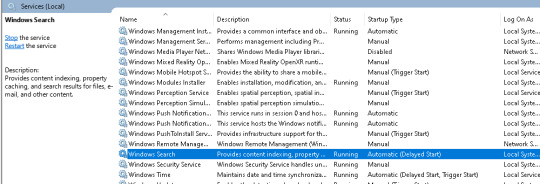
On the file server(s) in particular, you need to ensure that the Search Service Windows Server feature is also installed. If not, you need to install it via Powershell and reboot the file server(s). Install-WindowsFeature Search-Service # Ensure the feature has been installed Get-WindowsFeature # Reboot server(s)
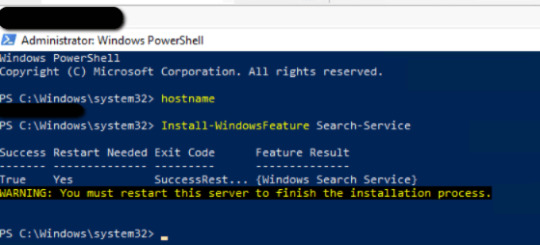
- Check if network discovery is turned off on the Windows machine you are troubleshooting. To check this, search for "manage advanced sharing settings" in start menu and then ensure that "network discovery and "file and printer sharing" options are turned on in the affected network profiles (private, public, all networks).

- Check the NTFS and SMB share permissions on the target file server share. Ensure that all desired source machines have full SMB share permissions on the shares you wish to index. - If the issue lies in a mapped network drive, try adding the drive as a network location (shared folder) instead of a mapped network drive. An alternative approach is to type the UNC path of the mapped network drive instead. Finally, in case you have provisioned the mapped drives by using the hostname or FQDN of the file server, try to recreate the mapped drives but this time by using the server's IP address. This can be helpful in cases where you are accessing the mapped drives via a workgroup (non-domain) machine via VPN and the DNS resolution does not work as expected. - Reset the Indexing database on the local computer. Navigate in Windows start menu to "indexing options" then click the "Advanced" button and click the "Rebuild" option. This will force Windows to re-build the search index. This can take a long time (hours, depending on the size of your file data). You may also need to rebuild the search index also in your file server.
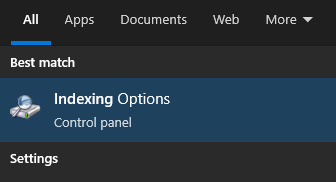
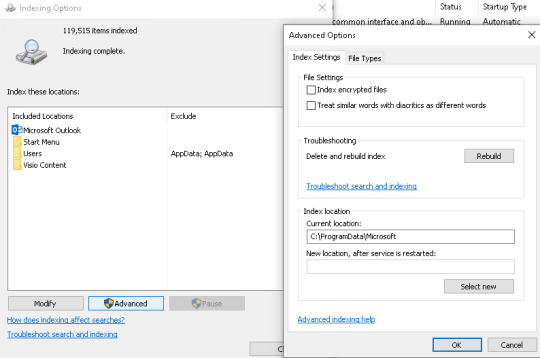
- If you are troubleshooting search of a network drive file contents, right-click on the network drive and click on Properties. Check Allow files on this drive to have contents indexed in addition to file properties.
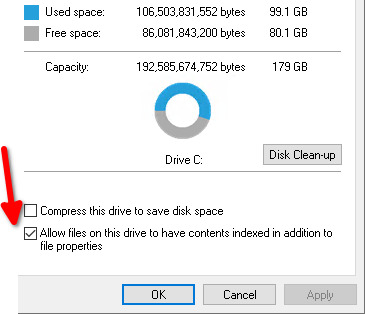
- Configure search options for the disk you are troubleshooting. To do this, double-click on the drive in File Explorer. Next, select the explorer.exe View tab, click on the Options icon and configure the available options on the "Search" tab.
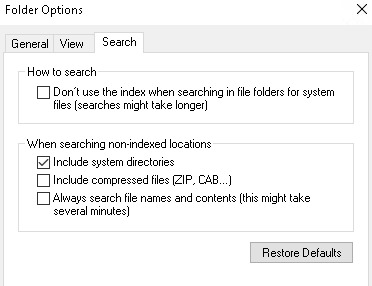
- Go to Settings on the Windows 10 desktop, then click on Search, followed by Searching Windows. As you can see in the screenshot below, this screen shows you how many items have been indexed and what indexing model is being used. Check the indexing status and any potentially excluded folders. You should also run the Windows indexing troubleshooter.
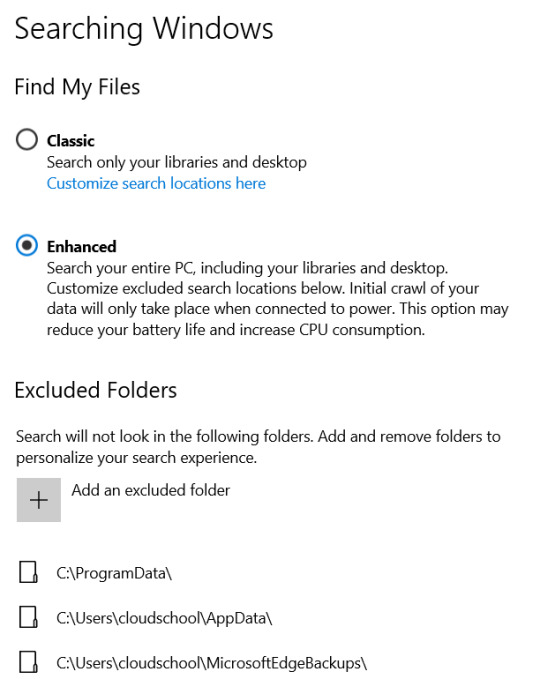

- If the issue you are having is with Excel .xlsx or .xls files, then you need to review the following articles and ensure that you have installed the MS Office Filter Pack 2.0 and the latest Windows updates on the affected file server, then run a re-built of the Windows indexing database.- https://community.spiceworks.com/topic/2201614-unable-to-search-content-within-excel-documents-stored-on-server-2016 - https://www.mcbsys.com/blog/2012/12/index-microsoft-office-files-for-windows-search-on-server-2012/ - https://support.microsoft.com/en-us/topic/july-2-2019-update-for-office-2010-filter-pack-kb3114879-5e29d31d-7c34-d861-63ab-659a707619cb - https://social.technet.microsoft.com/Forums/en-US/d792b518-ae53-44f0-81b9-3250a3538f96/server-is-not-indexing-excel-xlsx-files-but-is-indexing-older-excel-xls-files?forum=winserveressentials - Review the following KB article which includes additional suggestions on how to fix Windows Search issues: https://docs.microsoft.com/en-us/troubleshoot/windows-client/shell-experience/fix-problems-in-windows-search. This articles advises you to run the Windows search and indexing troubleshooter as well restart and reset the Windows Search service by using the following Powershell script (ResetWindowsSearchBox.ps1): https://www.microsoft.com/en-us/download/100295. Read the full article
#Fileserver#indexing#mappeddrive#search#SMB#Troubleshooting#UNC#Windows10#windowssearch#WindowsServer
0 notes
Photo

MODEL KHỦNG CÓ MẶT ĐẦU TIÊN Ở VIỆT NAM - SA3200D
Với thiết kế có sẵn 12-bay chứa ổ cứng và có thể nâng cấp lên 36-bay nhờ thiết bị mở rộng. Ngoài ra thiết bị có nhiều điểm làm cho cho nhiều doanh nghiệp cực kỳ yêu thích 😉
Chi tiết vui lòng liên hệ: 🏤 MSTAR CORP 📱Hotline : 0943.199.449 - 0909.514.461 📧Email : [email protected] 🌐Website : https://www.mstarcorp.vn/ 🛒Store: https://store.mstarcorp.vn 🙌Group hỗ trợ kỹ thuật: https://www.facebook.com/groups/synologyvn/ 🔎Add: Tầng 1, 75 Hoàng Văn Thụ, Phường 15, Quận Phú Nhuận, TPHCM.. 🔎Chi nhánh Hà Nội : Tầng 11, tòa nhà Zen Tower, 12 đường Khuất Duy Tiến, P.Thanh Xuân Trung, Q. Thanh Xuân, TP. Hà Nội #MstarCorp #synologyvietnam #seagate #synology #synologystorage
#mstarcorp#synologyvietnam#seagate#synology#synologystorage#dataserver#videostation#nassynologyvietnam#nas#nasstorage#nasdevice#synologydiskstation#giaiphap#fileserver#thaythefileserver#giaiphapgiamsat#surveillancestation#giamsatcamera#publiccloud#ocungroi#thaythepubliccloud#serviceprovider#muanassynology#ds220#ds920#flashsale#sa3200d
0 notes
